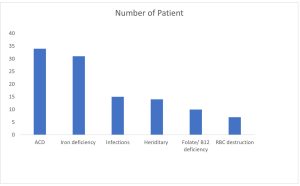
ABSTRACT
Background
In hospitalized patients who are elderly and frequently have multiple comorbidities, anemia is very prevalent. The two types of anemia that are most common are iron deficiency anemia and chronic illness anemia. To assess the frequency and causes of different types of anemia in hospitalized patients using a diagnostic parameter.
Materials and Methods
According to the inclusion and exclusion parameters, a total of 111 patients were enrolled. Information was gathered from the patient’s medical documents after they were examined. Statistical analysis was done.
Results
Anemia was most frequently seen in people between the ages of 31 and 45, with 22.03% of men and 40.38% of women, and a mean age of 37.24. years. Of these, 56.75% had anemia of mild severity. It was also found that patients with chronic kidney disease and iron deficiency are the most common causes of anemia, respectively. Anemia due to chronic disease was more prevalent (30.63%), followed by iron deficiency anemia in 27.92%. Malaise (48.64%) and pallor (36.03%) were the most prevalent symptoms and signs, respectively.
Conclusion
In hospitalized patients, anemia played a significant role in deciding mortality, morbidity, and outcomes. Early detection, haemoglobin level restoration, and maintenance in these individuals may have a substantial impact on the clinical improvement of various pathological conditions.
